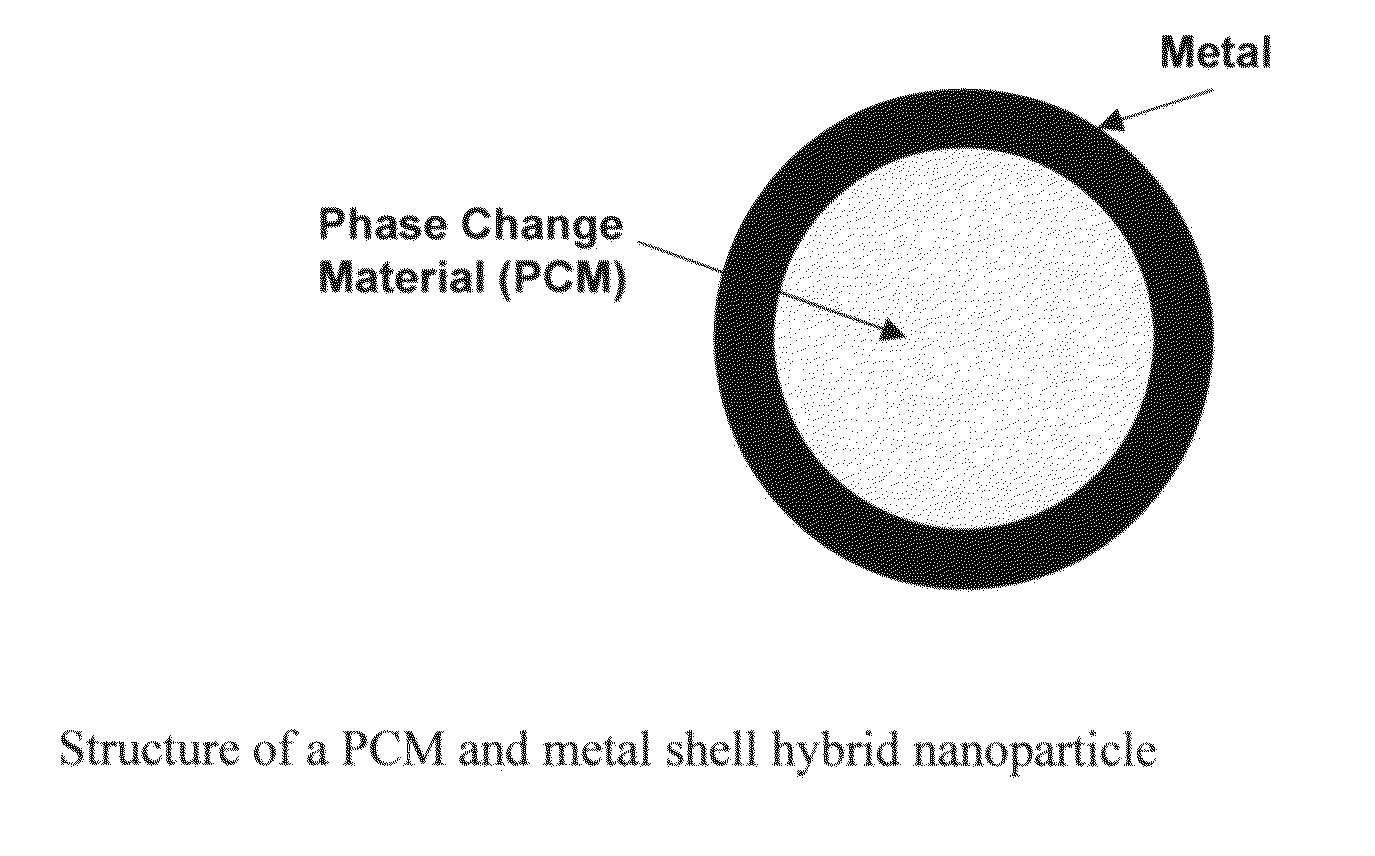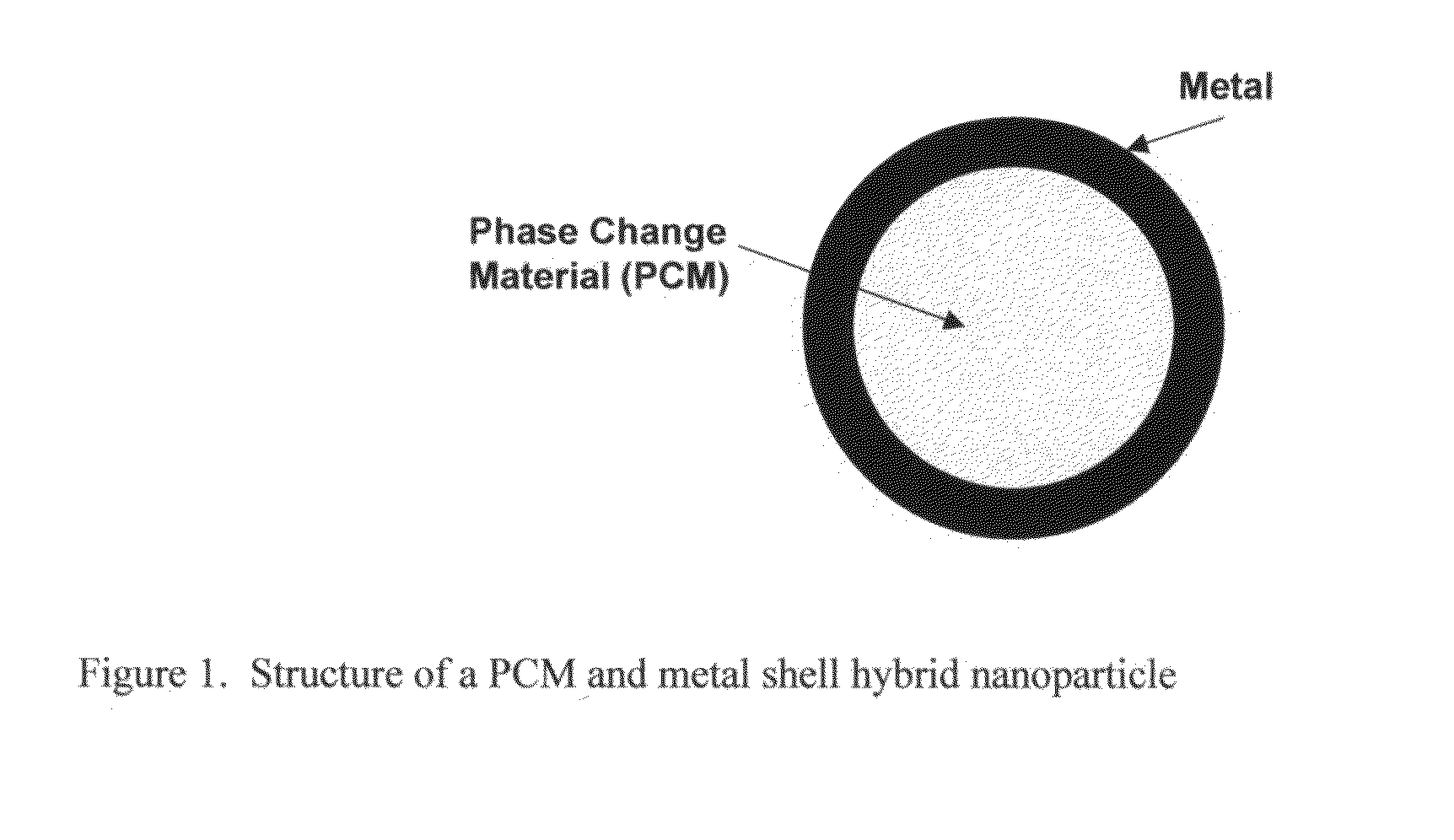Hybrid nanoparticles
a nanoparticle and hybrid technology, applied in the field of hybrid nanoparticles, can solve the problems of insufficient single-phase liquid cooling of high heat flux applications, inability to use water, and inferior thermo-physical properties of pure water
- Summary
- Abstract
- Description
- Claims
- Application Information
AI Technical Summary
Benefits of technology
Problems solved by technology
Method used
Image
Examples
example 1
[0024]Step 1:Paraffin (PCM) is melted at 65° C. The melting point of the paraffin is 50° C. in this example.[0025]Step 2: Melted paraffin is added to water containing sodium stearic acid (an emulsifier) at 65° C. using high shear mixing to create an emulsion of the paraffin in water. Alternatively, paraffin can be added to water containing sodium stearic acid. Then the mixture can be heated to 65° C. and mixed by applying high shear to create an emulsion of the paraffin in water.[0026]Step 3: The resulting emulsion is cooled below the melting point of paraffin (for example to about 50° C.) to solidify the paraffin. The result is a dispersion of the paraffin core particles in the water medium.[0027]Step 4: The surfaces of the paraffin particles are sensitized by stannous chloride.[0028]Prepare the following mixture:[0029]40 ml / l HCl[0030]7.5 g / l stannous chloride[0031]Expose paraffin particles from Step 3 to the HCl / stannous chloride mixture, above, for 5 min.[0032]Step 5: The surfac...
example 2
[0046]Step 1: Paraffin (PCM) is melted at 65° C. The melting point of the paraffin is 50° C. in this example.[0047]Step 2: Melted paraffin is added to water containing sodium stearic acid (an emulsifier) at 65° C. using high shear mixing to create an emulsion of the paraffin in water. Alternatively, paraffin can be added to water containing sodium stearic acid. Then the mixture is heated to 65° C. and mixed by applying high shear to create an emulsion of the paraffin in water.[0048]Step 3: The resulting emulsion is cooled below the melting point of paraffin (for example to about 50° C.) to solidify the paraffin. The result is a dispersion of the PCM core particles in water medium.[0049]Step 4: Gold nanoparticles (about 1-10 nm) of an opposite charge to that of the paraffin are added to the dispersion.[0050]Step 5: Sodium stearic acid is added as a stabilizer and the gold particles are heteroflocculated on the paraffin particles by electrostatic attraction (due to opposite charges). ...
example 3
[0071]Step 1: Paraffin (PCM) is melted at 65° C. The melting point of the paraffin is 50° C. in this example)[0072]Step 2: Melted paraffin is added to water containing sodium stearic acid (an emulsifier) at 65° C. using high shear mixing to create an emulsion of the paraffin in water. Alternatively, paraffin can be added to water containing sodium stearic acid. Then the mixture can be heated to 65° C. and mixed by applying high shear to create an emulsion of the paraffin in water.[0073]Step 3: The resulting emulsion is cooled below the melting point of paraffin (50° C.) to solidify the paraffin. The result is a dispersion of the PCM core particles in water medium.[0074]Step 4: Polyvinyl pyrrolidone (polymer) is added to the aqueous phase and dissolved by stirring.[0075]Step 5: The resultant mixture is cooled to about 25° C. (below the Theta point of polyvinyl pyrrolidone). The polymer is adsorbed on the PCM surface to create a thin shell.[0076]The next step is to create the metal sh...
PUM
| Property | Measurement | Unit |
|---|---|---|
| diameter | aaaaa | aaaaa |
| thermal conductivity | aaaaa | aaaaa |
| diameter | aaaaa | aaaaa |
Abstract
Description
Claims
Application Information
 Login to View More
Login to View More - R&D
- Intellectual Property
- Life Sciences
- Materials
- Tech Scout
- Unparalleled Data Quality
- Higher Quality Content
- 60% Fewer Hallucinations
Browse by: Latest US Patents, China's latest patents, Technical Efficacy Thesaurus, Application Domain, Technology Topic, Popular Technical Reports.
© 2025 PatSnap. All rights reserved.Legal|Privacy policy|Modern Slavery Act Transparency Statement|Sitemap|About US| Contact US: help@patsnap.com



